WebOS vs Android TV is a highly discussed topic in the streaming sector.
WebOS, developed by LG, is known for its user-friendly interface and intuitive navigation. It offers a streamlined experience, making it easy for users to access their favorite apps and content.
On the other hand, Android TV, developed by Google, provides a more extensive app ecosystem through the Google Play Store, along with powerful integration with Google services like Google Assistant and Chromecast.
Both WebOS and Android TV have evolved into highly adaptable platforms for streaming applications. In this blog, we will highlight the key differences between WebOS and Android TV, and help you find out which smart TV ecosystem is best for your streaming audience.
Let’s get started with a little overview of WebOS and Android TV platforms.
What is WebOS TV?
WebOS is a Linux-based smart TV operating system, originally developed by Palm Inc., but later acquired by LG in 2013. Initially, WebOS was exclusively designed for smartphones, but then it was adapted for Smart TVs.
WebOS TV gained popularity when LG launched its first smart TV with this efficient and user-friendly OS. The LG WebOS’s easy navigation and simple UI became the standout features, and since then, LG has maintained that reputation with a clean and intuitive interface.
Pros of LG WebOS:
- User-friendly interface – No complex technicalities
- LG TV OS ensures smooth performance and minimal crash
- Robust security features – No risks for vulnerabilities
Cons of LG WebOS:
- WebOS TV is only compatible and optimized for LG TVs and devices
- Customization options on WebOS TV are limited
- The app ecosystem of LG Web OS has limitations
Want to build an LG TV app for your streaming platform? Try Muvi’s No-code app development framework. Get Started!!!
What is Android TV OS?
Android TV OS is a smart TV operating system based on the same Android OS that powers millions of smartphones. It was developed by Google in 2014 to provide the Android experience on big TV screens.
Android TV OS allows users to access the powerful app ecosystem and content they get on their Android phones. Starting from streaming apps like Netflix to multi-player online and offline gaming and voice search, users can experience the enhanced version of all available on Android phones on the big screen through Android TVs.
Pros of Android TV:
- Extensive App ecosystem via Google Play Store
- Comes with built-in Google-Assistant
- Google provides regular security updates for Android TV OS
- Android TV offers endless customization options for developers
Cons of Android TV OS:
- Inconsistent performance on other smart TVs
- Complex development environment
- More prone to security vulnerabilities due to open-source nature
Develop an Android TV app for streaming platforms without coding. Get started with Muvi One. Sign up!!!
Are Google TV and Android TV the same?
People often tend to confuse Google TV and Android TV. Note that Google TV is an updated version of Android TV. In June 2014, Google TV succeeded Android TV with a revamped user experience and features.
Simply put, Google TV offers a new updated user interface with a different look and feel, whereas Android TV OS provides the fundamental framework and architecture for the interface.
Despite the upgrade, Android TV OS has great demand because of its distinct features and lower price. And the best thing is that Google has been updating Android TV at intervals with the latest integrations and developments.
For more information on Google TV vs Android TV, please refer to this guide.
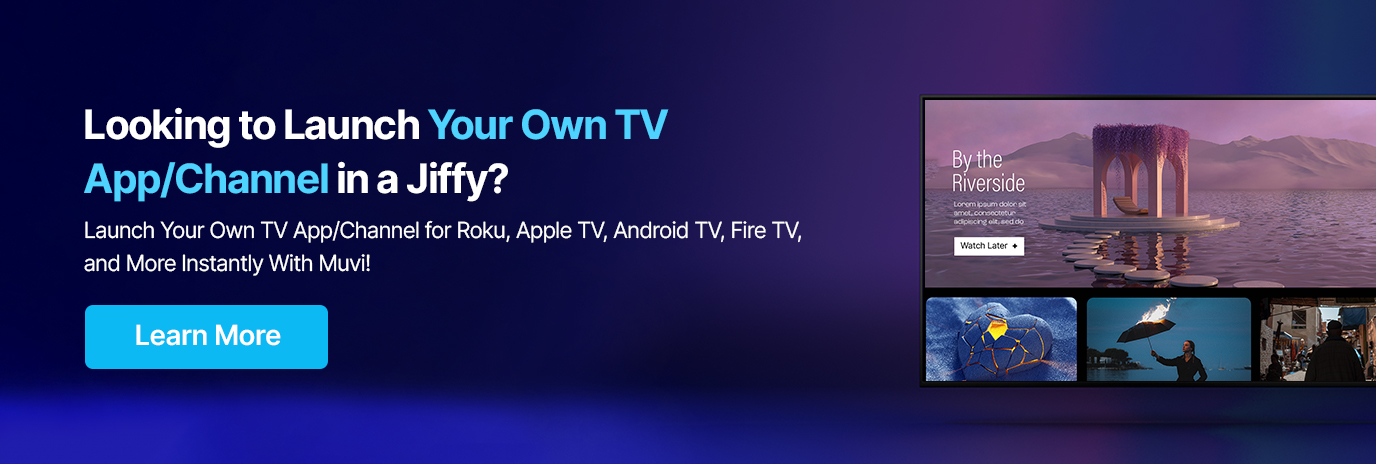
WebOS vs Android TV: The Key Differences
Google’s Android TV OS and LG’s WebOS are two of the most popular smart TV operating systems in the market. When developing apps for these smart TV platforms, it’s crucial to understand the key differences between WebOS and Android TV.
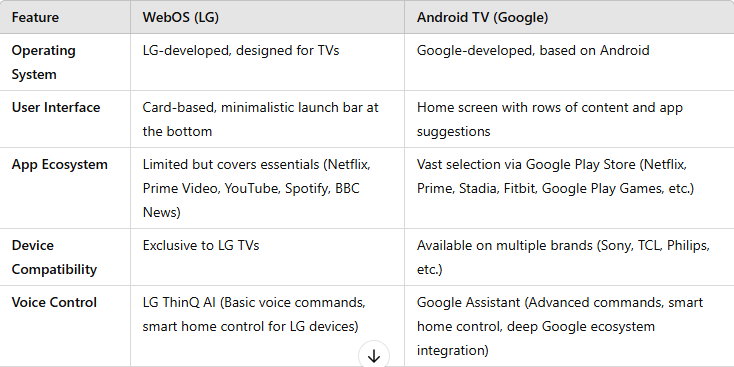
1. WebOS vs Android TV: Operating System
WebOS, developed by LG Electronics, is an operating system specifically designed for smart TVs. It gained acclaim for its user-friendly interface and streamlined navigation. One of its standout features is the “Card” system, where open apps are represented as cards on the screen, allowing users to switch between them effortlessly.
WebOS TV emphasizes simplicity, ease of use, and affordability, making it an attractive option for those seeking a straightforward and intuitive smart TV experience. Additionally, its development environment and unique characteristics set it apart from competitors, making it a strong contender in the smart TV market.
Android TV, on the other hand, is an iteration of the Android operating system optimized for television displays. Developed by Google, Android TV offers a familiar interface for users already accustomed to Android smartphones and tablets.
It boasts a vast app ecosystem through the Google Play Store, providing access to a wide range of applications, including streaming services, games, and productivity tools. The voice-controlled Google Assistant integration adds a convenient dimension to Android TV, enabling users to search for content and control the TV using voice commands.
2. WebOS vs Android TV: App Ecosystem
LG WebOS has made significant strides in expanding its app ecosystem, especially in the realm of streaming services. Popular apps are readily available, ensuring a robust entertainment experience. Some of the popular apps are –
- Entertainment: Netflix, Amazon Prime Video, Disney+, YouTube
- Music Streaming: Spotify, Pandora
- News and Information: BBC News, CNN, Reuters, HuffPost
However, where WebOS may lag behind Android TV is in the broader range of third-party apps. While it covers essential categories like entertainment, music, and web browsing, it might not have the same depth of specialized apps found in the Google Play Store.
Android TV, powered by Google’s ecosystem, boasts a vast and diverse app library through the Google Play Store. This includes an extensive collection of apps such as
- Entertainment: Netflix, Amazon Prime Video, Hulu, Disney+, YouTube
- Music Streaming: Spotify, Pandora, Apple Music
- Gaming: Google Play Games, Stadia (game streaming service), NVIDIA GeForce NOW
- Fitness and Health: Fitbit, MyFitnessPal, Peloton
- News and Information: CNN, BBC News, NPR News, Bloomberg
Android TV undoubtedly excels in app variety and depth. It offers a more extensive selection of specialized apps across diverse categories, appealing to a broader range of user interests.

3.WebOS vs Android TV: Device Compatibility
WebOS is primarily associated with LG Electronics, and it powers LG’s line of smart TVs. While LG has a significant market presence, WebOS is relatively limited in terms of device compatibility. If you opt for a WebOS-powered TV, your experience will be tailored to that specific television brand.
Android TV, developed by Google, offers a more extensive range of device compatibility. It is not limited to a single manufacturer but is adopted by various TV brands, including Sony, Philips, TCL, and more. This broader adoption means that you can find Android TV OS on smart TVs from different manufacturers, providing you with more options to choose from.
Android TV’s compatibility with multiple TV brands gives consumers the freedom to select a television that aligns with their preferences in terms of design, specifications, and price range. You are not restricted to a specific manufacturer.
Also, Android TV seamlessly integrates with the broader Google ecosystem, including Google Assistant, Google Home, and Chromecast. This interconnectedness enhances the users’ smart home and multimedia experiences, especially if they are already using Google services and devices.
4. WebOS vs Android TV: Voice Control
LG WebOS integrates voice control through its AI assistant, which is typically referred to as “LG ThinQ AI” or “LG Voice.” WebOS supports basic voice commands for tasks like changing channels, adjusting volume, and launching specific apps. Users can activate voice control by pressing a dedicated button on their remote.
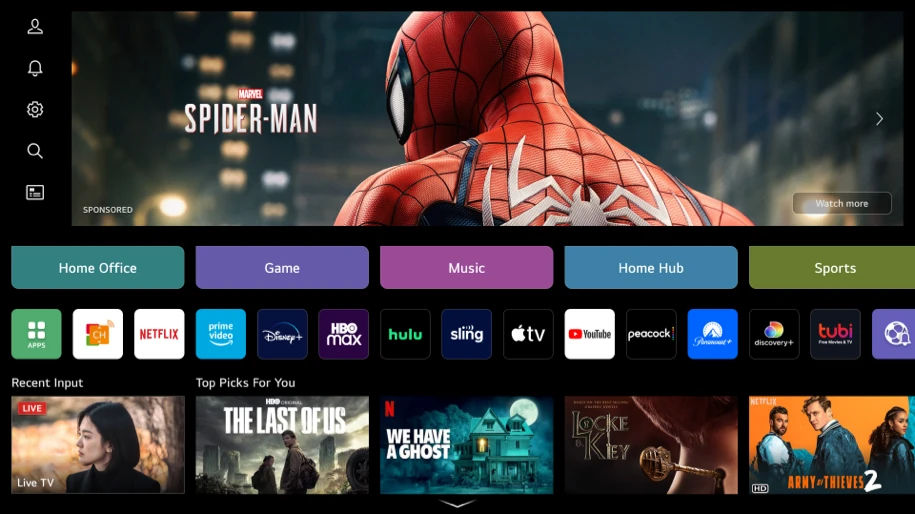
WebOS uses natural language processing to understand and respond to user commands conversationally. This means you can speak naturally rather than using specific phrases or keywords.
LG ThinQ AI extends voice control to LG smart home devices. Users can control compatible appliances, lighting, and more using voice commands through their LG TV.
Android TV, on the other hand, leverages the power of Google Assistant for voice control. Android TV seamlessly integrates with Google Assistant, one of the most advanced virtual assistants available. Users can activate voice control by pressing a dedicated button on their remote or by using a wake word like “Hey, Google.”
Google Assistant on Android TV supports a wide range of voice commands, including search queries, content playback control, smart home device control, weather updates, and more. It can answer questions, provide recommendations, and interact with various Google services.
Google Assistant excels at contextual understanding, allowing users to ask follow-up questions or make requests based on previous interactions. This makes voice control more intuitive and flexible.
Chromecast Integration: Android TV’s voice control extends to Chromecast functionality, enabling users to cast content from their mobile devices using voice commands.
5. WebOS vs Android TV: Learning Curve
LG WebOS is renowned for its user-friendly and intuitive interface. It was designed with simplicity in mind, making it accessible to users of all technical backgrounds. WebOS features a straightforward navigation system with an uncluttered home screen. It uses a “Card” system for open apps, allowing users to switch between them effortlessly.
The simplicity of WebOS means that users can quickly grasp the basics of operating their smart TV. Basic tasks like changing channels, adjusting the volume, and launching apps are straightforward and intuitive.
WebOS incorporates natural language processing for voice commands, allowing users to interact with their TV conversationally. This enhances the user experience and reduces the learning curve associated with voice control.
While LG WebOS offers a range of smart features, they are presented in a user-friendly manner. Users can easily access streaming services, apps, and device connections without feeling overwhelmed.
Android TV offers a versatile platform with a range of features and customization options. However, the learning curve for Android TV can vary depending on the user’s familiarity with Android and their tech-savviness.
Android TV provides extensive customization options, which can be appealing to tech-savvy users. However, for those less familiar with Android, these options may require some exploration and learning.
Users who are already part of the Google ecosystem may find Android TV’s integration with Google services seamless and familiar. This can reduce the learning curve for tasks like setting up accounts and accessing content.
Android TV’s access to a vast library of apps can be overwhelming for some users. Finding and managing apps may take time for those new to the platform.
6. WebOS vs Android TV: User Interface
The user interface is the first noticeable factor that distinguishes between an Android TV and LG WebOS. While both of them have gone through changes over the years to come out to be easily comprehensible, each of them has its unique representation.
For instance, in WebOS, the list of content appears as a ribbon-like customizable launch bar at the bottom of the screen that contains the list of apps, TV settings, features, etc. While in Android TV, the content rows occupy the home screen of the smart TV.
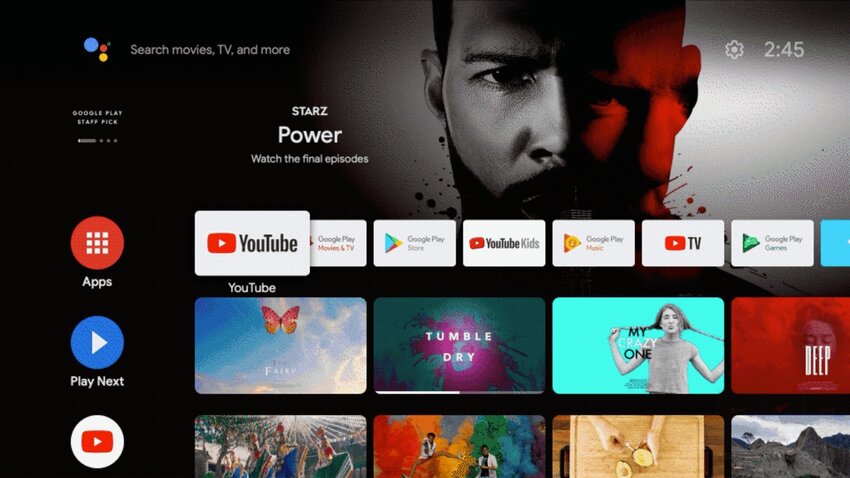
In Android TV, if one app is opened and you want to open another app, you need to close the first app and go to the home screen. But in the case of WebOS, you can get access to the launch bar anytime you want, even if another app is opened. As you can see, it’s easier to navigate in WebOS, but the learning curve is steeper in this case. Another prominent difference is – the Android TV interface is more similar to the Android smartphones, while the WebOS is not.
Build feature-rich smart TV apps from scratch with Muvi One. Start today!
7. WebOS Vs Android TV: Screencasting
Screencasting lets you mirror the content playing on your smart devices to a bigger screen. While all smart TVs have this feature, the technology varies for different operating systems.
For instance, the SmartShare feature of WebOS lets you watch all the multimedia content on TV. On the other hand, Android TV‘s built-in Chromecast technology allows you to share content from the apps supporting Chromecast like YouTube, Netflix, Disney+, Hulu, Prime Video, etc.
8. WebOS Vs Android TV: Additional Features
In addition to the features mentioned earlier, both WebOS and Android TV offer a range of additional features that enhance the viewing experience. WebOS, for example, offers a feature called “Multi-Device Control,” which allows users to control other smart devices in their home using the TV remote. This feature is particularly useful for those who have a variety of smart devices, as it centralizes control and simplifies the user experience.
Android TV, on the other hand, offers a feature called “Google Play Games,” which allows users to play games on their TV using a controller or other device. This transforms the TV into a gaming console, providing access to a wide range of games available on the Google Play Store. Additionally, Android TV supports Google Assistant, enabling users to control their TV and other connected devices using voice commands.
Both platforms also offer unique smart features that cater to different user needs. For instance, WebOS’s Magic Remote provides a point-and-click interface, making navigation more intuitive. Meanwhile, Android TV’s integration with Google services ensures seamless connectivity with other smart devices in your home, enhancing the overall smart home experience.
This was all about WebOS vs Android TV. We have listed all the key differences between WebOS and Android TV above.
Choosing the Right Smart TV Operating System: WebOS Vs. Android TV
Choosing the right smart TV operating system can be a daunting task, especially with so many options available in the market.
If you’re looking for a simple and intuitive interface, WebOS may be the right choice for you. If you’re looking for a more extensive app selection and customization options, Android TV may be the way to go. Ultimately, the choice between WebOS vs Android TV depends on your individual needs and preferences.
However, when opting for Smart TV app development, it’s recommended to focus not only on the OS but also the market size, user’s choice, and ease-of-development. You should keep this in mind when launching your WebOS or Android TV app.
Muvi, the all-in-one OTT platform provider, lets you launch your own fully featured, white-labeled WebOS or Android TV app easily. Some of the exclusive perks offered by Muvi include a fully managed streaming solution, multiple monetization options, and a no-coding framework!
Take a 14-day free trial of Muvi One and launch your webOS or Android TV app without any coding.

Recommended Reads:
Google TV Vs Android TV: A Comparative Guide
Samsung TV Vs LG TV – A Comparative Study
Tizen OS Vs Android TV: The Key Differences
What are the Differences Between Android TV and Fire TV?
Google TV Vs LG TV: All You Need To Know
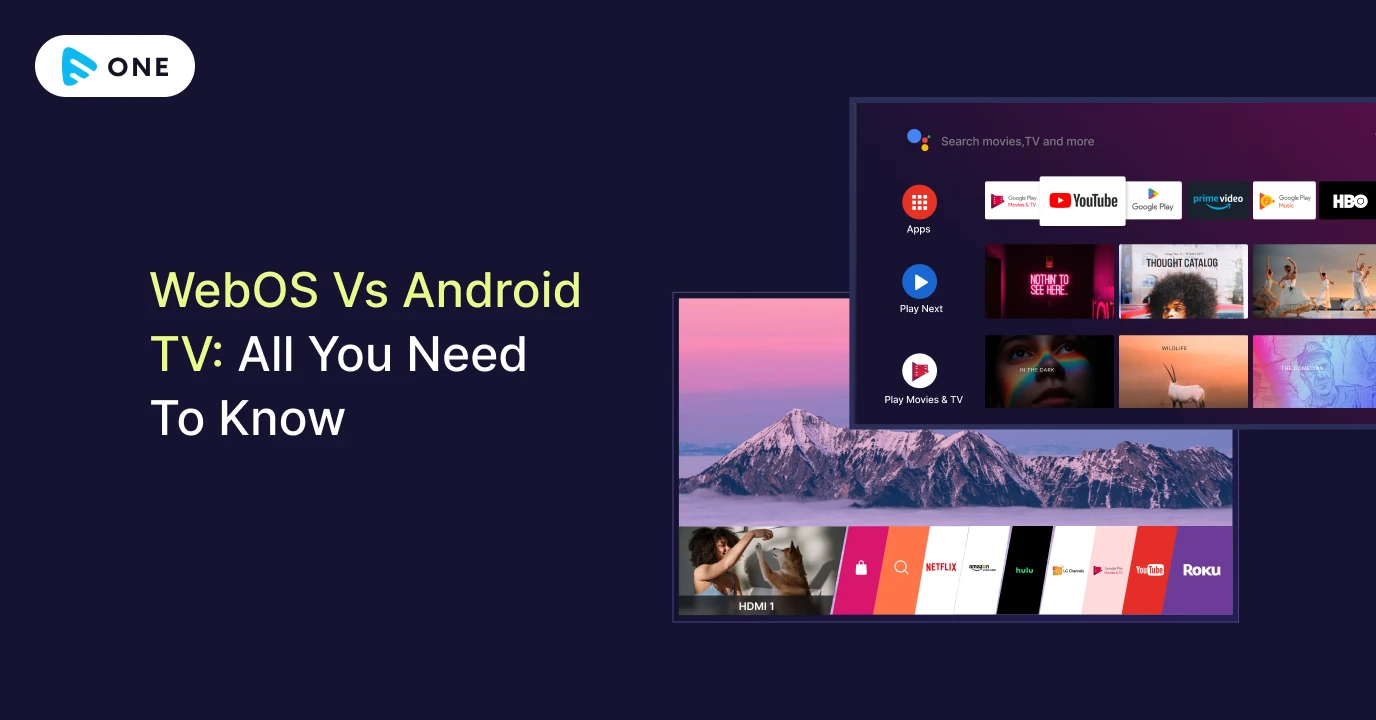


















Add your comment